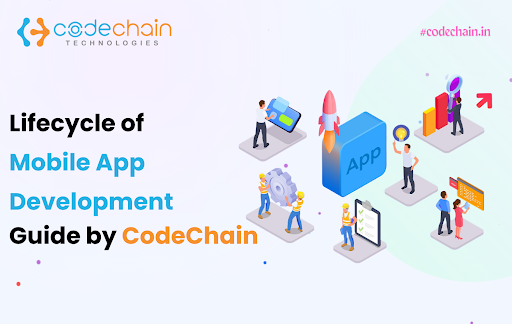
In the fast-paced digital economy, mobile app development has become one of the most crucial components of business success. With more than 6.8 billion smartphone users worldwide, mobile applications have revolutionized how we communicate, shop, work, and entertain ourselves. However, creating a successful mobile app isn’t just about coding—it’s about following a structured process known as the mobile app development lifecycle.
At CodeChain Technologies, we understand that delivering a high-quality Android app development, iOS app development, or cross-platform mobile app development project requires precision, creativity, and technical expertise. Whether you’re a start-up looking to disrupt the market or an enterprise aiming to expand your digital presence, knowing each stage of this lifecycle will help you make better decisions and ensure your app stands out.
This comprehensive guide breaks down the mobile app development lifecycle, highlights best practices, and explains why choosing the right mobile app development company, like CodeChain Technologies, can make all the difference.
What Is the Mobile App Development Lifecycle?
The mobile app development lifecycle is a structured process consisting of several stages, from the initial idea to deployment and beyond. It ensures that your app is built systematically, meets user expectations, and adapts to market demands.
By following this lifecycle, businesses can:
Reduce development risks
Deliver better user experiences
Ensure scalability and maintainability
Achieve faster time-to-market
Stage 1: Idea & Requirement Gathering
Every great app begins with a solid idea. This stage involves:
Market Research: Understanding the current trends and identifying gaps in the market.
Competitor Analysis: Studying similar apps to find strengths and weaknesses.
Defining Objectives: Knowing the problem your app solves.
Target Audience Identification: Determining who will use your app and why.
Feature List Creation: Outlining must-have and nice-to-have features.
Pro Tip: At CodeChain Technologies, we use data-driven insights to validate app ideas before moving forward, ensuring your investment has the highest chance of success.
Stage 2: Planning & Wireframing
Once the idea is validated, the next step is planning the app architecture and creating wireframes.
Key deliverables include:
Project Timeline: Breaking down the development process into sprints (Agile methodology).
Technology Stack Selection: Choosing between native mobile app development (Kotlin, Swift) and cross-platform app development (Flutter, React Native).
Wireframes: Blueprint sketches of the app’s interface and navigation flow.
At CodeChain, our UX specialists ensure that even at the wireframe stage, your app has a logical flow and intuitive navigation.
Stage 3: UI/UX Design
This stage focuses on creating an engaging user interface (UI) and smooth user experience (UX).
Best practices include:
Consistency in Design: Using a unified color scheme and typography.
Responsive Design: Ensuring compatibility with different devices and screen sizes.
Interactive Prototypes: Allowing stakeholders to test navigation before coding begins.
Why it matters: A visually appealing and user-friendly design increases user retention and app ratings.
Stage 4: Development (Coding)
The actual coding phase brings the design to life. Developers build the front-end (user interface) and back-end (server, database, and APIs) components.
Development types:
Native App Development: Built specifically for Android or iOS for maximum performance.
Cross-Platform App Development: One codebase for both platforms using Flutter or React Native.
At CodeChain Technologies, we follow Agile development—ensuring flexibility, faster iterations, and regular feedback cycles.
Stage 5: Testing & Quality Assurance
Before launch, the app undergoes rigorous testing to ensure it works flawlessly.
Testing types include:
Functional Testing: Ensuring all features work as intended.
Usability Testing: Checking ease of navigation.
Performance Testing: Verifying speed, load times, and responsiveness.
Security Testing: Protecting against data breaches and cyberattacks.
Device Compatibility Testing: Testing across different devices and OS versions.
At CodeChain, our QA experts use both manual and automated testing tools to ensure zero critical bugs.
Stage 6: Deployment & Launch
After passing all tests, the app is ready for deployment to the Google Play Store or Apple App Store.
Key steps:
App Store Optimization (ASO): Optimizing title, description, and keywords for better discoverability.
Compliance Checks: Ensuring the app follows store policies.
Marketing Campaigns: Creating awareness before and after launch.
At CodeChain Technologies, we assist clients with a smooth app submission process and pre-launch marketing.
Stage 7: Post-Launch Support & Maintenance
Once the app is live, continuous maintenance keeps it functional and competitive.
Ongoing activities include:
Fixing bugs reported by users
Releasing feature updates
Optimizing performance
Ensuring compatibility with OS updates
Monitoring analytics for improvements
Tip: Post-launch care is just as important as development, and CodeChain offers long-term maintenance plans to keep your app at peak performance.
Best Practices for Successful Mobile App Development
Start with Clear Goals—Define the problem your app solves.
Focus on UI/UX—A great design keeps users engaged.
Prioritize Security—Protect user data with secure APIs and encryption.
Test Extensively—Avoid negative reviews due to bugs.
Plan for Scalability—Your app should grow with your business.
Update Regularly—Keep users interested with fresh features.
Why Choose CodeChain Technologies for Mobile App Development?
Choosing the right mobile app development company can make or break your project. At CodeChain Technologies, we provide:
- Expert Development Team – Skilled in Android, iOS, and cross-platform solutions.
- Agile Methodology—Faster delivery and adaptability.
- End-to-End Services—From idea validation to post-launch maintenance.
- High-Quality Assurance—Every app goes through rigorous testing.
- Proven Track Record—Delivered apps for startups, SMEs, and enterprises.
Address: CodeChain Technologies, 305-306, Amby Valley Arcade, Uttran, Surat, GJ - IN.
Phone: +91-261 356 0 756
Email: contact@codechain.in
Website: www.codechain.in
Frequently Asked Questions (FAQ)
1. How long does it take to develop a mobile app?
On average, it takes 2–6 months depending on complexity, features, and platform.
2. Which platforms do you develop for?
We specialize in Android app development, iOS app development, and cross-platform app development.
3. Do you offer post-launch support?
Yes, we provide app maintenance, performance monitoring, and feature updates.
4. Can you help with app store optimization?
Absolutely. We offer ASO services to improve app discoverability.
5. What is the cost of mobile app development?
Costs vary based on design complexity, feature list, and platforms chosen.
Conclusion
The lifecycle of mobile app development is a journey that requires careful planning, creative design, skilled development, and ongoing maintenance. By understanding each stage, you can avoid common pitfalls and create an app that delivers real value to users.
At CodeChain Technologies, we blend technical expertise, innovative thinking, and business insight to deliver mobile applications that stand out in today’s competitive market. Whether you need a native mobile app, a cross-platform solution, or an enterprise app, we have the skills and experience to bring your vision to life.
